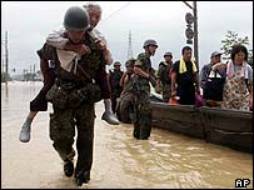|
|
Helping Those in Need
The Elderly Must Be Protected from Natural Disasters
Asahi Shinbun
Japan
August 2, 2004

The deluge that recently inundated coastal areas along the Sea of Japan demonstrated the alarming vulnerability of old people to natural disasters. Of the 21 people dead or missing, 17 are senior citizens aged 65 or older.
In the city of Sanjo, Niigata Prefecture, rushing torrents of muddy water engulfed a number of homes. As the city has no emergency wireless system in case of natural disasters, its instructions to evacuate failed to reach residents quickly. In the town of Nakanoshima, there could have been fewer casualties if evacuation advisories had been issued earlier.
The number of elderly people is growing at a staggering pace in Japan. Natural disasters can hit anywhere at any time. Swift policy actions must be taken to establish an effective system nationwide to evacuate residents in an emergency.
Unlike earthquakes, which are generally unpredictable, it is usually possible to limit damage from typhoons and flooding based on careful monitoring of weather conditions and water levels of rivers.
But the rivers that flooded the region in the recent downpours were all relatively small streams managed by prefectural governments. There was no adequate system to monitor water levels in these rivers. In contrast, large rivers under state jurisdiction are constantly monitored by cameras equipped with optical fibers, providing accurate, real-time information about rising water levels. This huge gap in anti-disaster preparedness must be eliminated.
Local governments should work out clear objective criteria for evacuation advisories and warnings. It would be absurd if this important safety step was delayed because of damage analysis or other administrative tasks. To avoid that, local authorities should create a system in which an evacuation advisory is issued automatically when the water level in a specific river reaches a certain predetermined height.
To ensure that word reaches people quickly, the authorities should install a wireless communication system and make use of existing facilities, such as cable television networks, for disaster prevention. A combination of steps has to be taken to ensure that vital information reaches everybody, particularly the old and infirm.
After suffering enormous damage from torrential rain in September 2000, Nagoya became the first city in this country to establish criteria for emergency evacuations of people from areas at risk from flooding. The city now issues preliminary alerts before water levels reach dangerous heights to give people sufficient time to prepare.
There are good reasons to urge elderly people to leave their homes to reach a safe place when a preliminary alert is issued. Having a safety-first policy would be supported by people even if evacuation advisories turned out to be unnecessary.
Another useful flood safety instrument is a flood hazard map identifying evacuation routes and dangerous spots. However, fewer than 300 of the roughly 1,200 local governments designated as flood-hazard areas under the flood control law have prepared hazard maps. All local governments lacking in this regard should rectify the situation as soon as possible.
Members of local communities, for their part, should establish mutual help programs for quick evacuations in emergencies, instead of relying entirely on local governments.
A group of volunteers in Gotenba, Shizuoka Prefecture, set up a system to rescue members of the community most at risk if the city is hit by a natural disaster. The system covers all the senior citizens in the city as well as people with disabilities who have registered with the group. Two or more volunteers are in charge of each person on the rescue list so nobody is left out in an emergency. The volunteers include junior and senior high school students.
Working with neighborhood associations, the volunteer group has conducted evacuation drills using a hazard map.
``We always care about these people,'' says Yaeko Kondo, who heads the group. ``We want them to know our feelings.''
|
|



